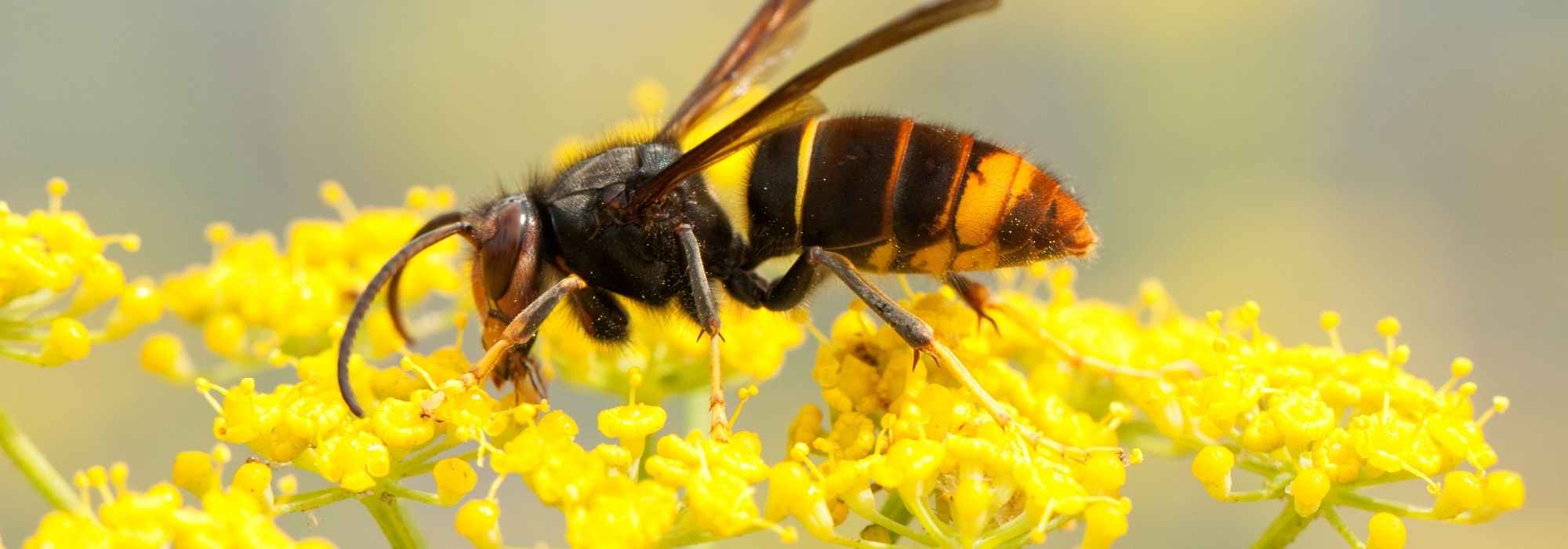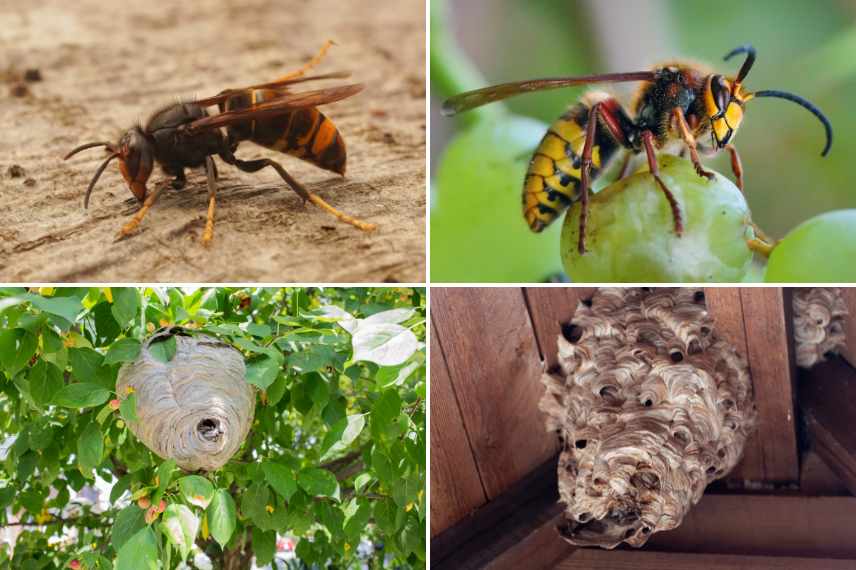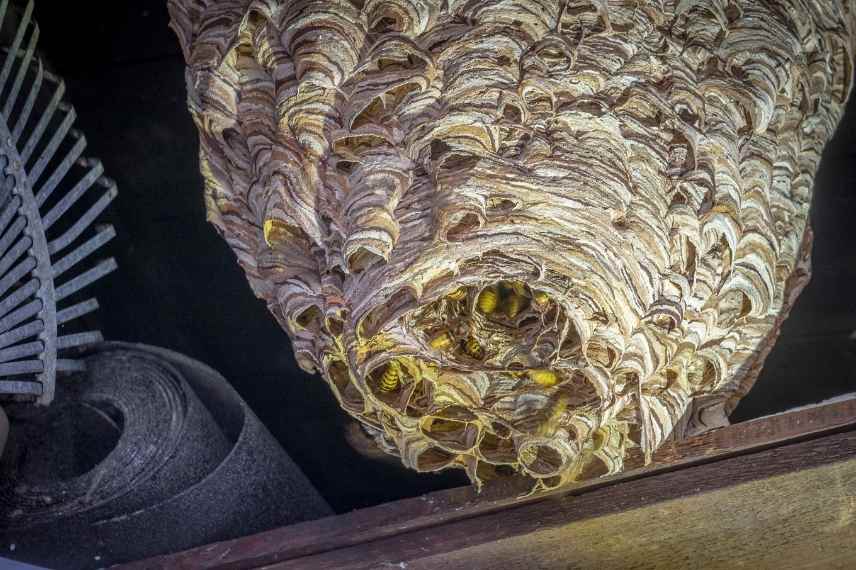
A Wasp Nest in Your Garden: What to Do?
Discover what you should or shouldn't do when hornets are confirmed to be present
Contents
A few years ago, I planted a beautiful honeysuckle (Lonicera) in my garden. While this honeysuckle pleasantly tickles my nostrils with the intense fragrance of its flowers, it also attracts hornets. And their proximity can be concerning, as this hymenopteran is impressive in size. Especially if it’s the dreaded Asian hornet with yellow legs (Vespa velutina nigrithorax), an invasive species whose presence on French soil has been confirmed since 2005. Relatively aggressive towards humans, the Asian hornet is primarily a formidable predator of our domestic and wild bees. In short, whether Asian or European, hornets build rather large nests that house thousands of individuals. And wooded gardens can harbour these nests… Hence a potential danger.
Let’s explore together how to identify the two species of hornets, and above all, how to react sensibly when encountering a nest.
How to identify the type of hornet and its nest?
In our gardens during summer, thousands of insects cross paths. Among them are the hymenopterans such as bees, wasps and hornets that buzz about incessantly. For novices, note that honeybees (Apis mellifera) and bumblebees, with their fuzzy bodies, are only interested in the flowers they visit and pollinate. Among the stinging hymenopterans, we find wasps and hornets. Wasps (Vespula), significantly smaller than hornets, can be recognised by their abdomen striated with yellow and black, clearly separated from the thorax (the famous “wasp waist”!). Then there are hornets…
Asian Hornet vs European Hornet
On French soil, only two hornets are encountered: the European hornet (Vespa crabo) and the yellow-legged Asian hornet (Vespa velutina nigrithorax). The former is native and very common, while the latter, accidentally imported from Southeast Asia in 2004, is considered an invasive species as it is a formidable predator of honeybees. It can also potentially become aggressive towards humans.
It is therefore essential to know how to distinguish the European hornet from the Asian hornet, while obviously taking all necessary precautions. However, by observing from a distance, the yellow-legged hornet can be fairly easily identified.
- The European hornet has an abdomen striped with yellow and black, a yellow head and brown legs. Its thorax is also marked with reddish-brown, black and yellow. It is larger than the Asian hornet. The European hornet is quite noisy during flight
- The yellow-legged Asian hornet can be recognised precisely… by its yellow-tipped legs. The abdomen has four segments, three of which are brown edged with yellow, while the fourth is orange-yellow. The thorax is brown-black, and the head is orange with a black forehead. Its flight is silent.

On the left, the Asian hornet and its nest; on the right, the European hornet and its nest
Different Nesting Sites
As for hornets’ nests, they are made of papier-mâché, created from plant fibres mixed with saliva, but they differ in shape and location between species:
- The European hornet’s nest is rather conical, with a diameter of less than 40 cm. It is established in a hollow or tree stump, a cavity, under eaves or roof overhangs, in an attic, in a chimney…
- The Asian hornet’s nest is more spherical and can reach 80 cm in diameter. It is built in the foliage of trees, often at height. This is why in spring and summer, they can sometimes be hard to spot. Only the presence of numerous hornets suggests a nest may be nearby. The Asian hornet also has the peculiarity of constructing a primary nest, smaller and temporary, in low branches or even on the ground.
What are the risks associated with having a wasps' nest in your garden?
The presence of a hornets’ nest in a garden poses a potential danger, especially if it is located near a walkway or human activity area. Indeed, at the slightest approach near the nest, the Asian or European hornets actively defend their colony and can become aggressive, even unintentionally. Their ray of vigilance can extend several metres and increases further when the nest is mature, by late summer. Bear in mind that a nest can contain thousands of individuals.
The main danger lies in the hornets’ ability to sting multiple times, without losing their stinger. A collective attack is possible when the colony perceives a threat, exposing the victim to dozens of stings. This can cause intense pain, extensive swelling, and in some cases, severe allergic reactions (one in five people!), ranging up to anaphylactic shock. These situations require immediate medical attention.

European hornets don’t hesitate to establish their nest in an attic or garden shed
Children, elderly people and pets are particularly vulnerable. It is therefore essential not to underestimate the presence of a nest, even if it seems remote from living areas.
The yellow-legged hornet poses a double problem. In addition to the risk to people, it attacks honeybees en masse at hive entrances , weakening colonies and threatening beekeeping activities. On the other hand, the European hornet is a useful garden ally, as it feeds on flies, caterpillars, butterflies, grasshoppers and locusts – potential garden pests.
What to do (or not to do) when you discover a wasps' nest?
When facing a hornet’s nest, whether European or Asian, absolute safety is the top priority. Never attempt to get too close or destroy a hornet’s nest, whether with an insecticidal spray, a water hose, or a gun. Such intervention would only increase the hornets’ aggressiveness for several days and raise the risk of multiple stings for you and your neighbours.
Similarly, it is advisable to keep your distance from the nest. Maintain at least 10 metres between yourself and the nest while monitoring the hornets’ flight. Completely restrict access to the area for children and pets.
However, note that a nest discovered between approximately November and March is empty, or only occupied by a few dormant fertilised queens. This period corresponds to the diapause, during which only the founding queens survive.
Next, the course of action depends on the type of nest, its size and its location. If the nest is close to a home, a public space, or a highly frequented area of your garden, it is recommended to contact a professional without delay. If it turns out to be an Asian hornet nest, you can contact your local town hall. Some local authorities have agreements with pest control companies or can direct you to an approved specialist. The Fire and Rescue Service (SDIS) generally only intervenes if public safety is directly endangered, for example if vulnerable people are present or if a nest is located on a public venue.
Reporting the nest can also be useful for the collective fight against the Asian hornet.
The importance of hiring a certified professional
Hiring a certified pest control professional may involve a cost, but it guarantees safety for your family. From June to November, this intervention is obligatory, as the nest often contains thousands of individuals.
Only a specialist equipped with full-body protective combinations, appropriate poles, and approved biocidal products can act safely. Asian hornet nests are typically destroyed using a telescopic pole and insecticidal injection. Once the nest is neutralised, the professional can remove it or leave it to degrade naturally if it no longer poses a risk.
European hornet nests, which are much more accessible, can be eliminated without insecticide. Simply block the entrance, enclose the nest in a bag, and kill the colony by freezing. This technique is, of course, reserved for professionals wearing specialised combinations.
Since hornets are diurnal insects, a good professional will intervene at dawn or dusk to eliminate the entire colony. Destroying a nest during the day can be counterproductive, as hornets flying outside the nest may potentially form another colony elsewhere.
It is important to ensure that the service provider is Certibiocide certified, a mandatory certification for handling professional-grade insecticidal products. Pest control specialists can usually be found online, via a professional directory, or through recommendations from your local council.
How much does wasp nest removal cost?
The cost of an intervention varies depending on the region, the access difficulty, the height of the nest and the time required. You should generally expect to pay between €80 and €180 for a standard removal.
Some local authorities or departments offer financial assistance or cover part or all of the costs, especially for Asian hornet nests identified as priority cases. It is therefore advisable to check with your local town hall before proceeding. In rural areas, beekeeping associations may also be involved, particularly when the nest poses a threat to nearby apiaries.
- Subscribe!
- Contents































Comments